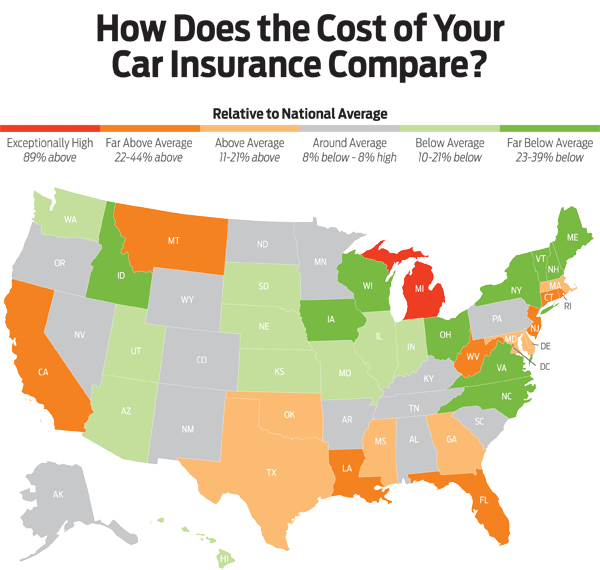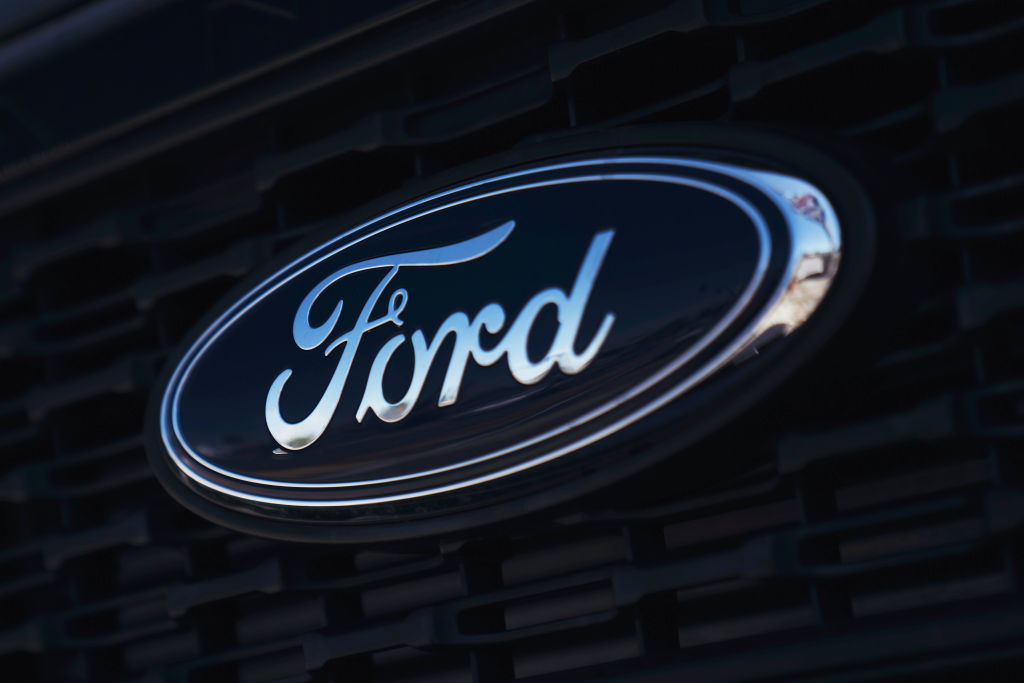Where You Live Has a Huge Effect on Car Insurance Rates
Laws, court rulings and driver behavior mean that someone across a state line might pay double (or half) of what you do.

When it comes to the cost of your car insurance, there are things you can control fairly easily, such as what you drive and how you drive it. And things you can't, such as where you live. In fact, differences in state laws, court rulings and driver behavior mean the insurance bill in one state could be more than double the bill on the same vehicle in another state.

Based on Insure.com data.
This is the fifth year of the study, which gathers quotes from six major insurers in multiple zip codes in all 50 states and Washington, D.C., averaging rates for the 20 best-selling vehicles nationwide. Those models, led by the Ford F-series pickup, represented 40% of the new-car market in the U.S. in 2014.

Sign up for Kiplinger’s Free E-Newsletters
Profit and prosper with the best of expert advice on investing, taxes, retirement, personal finance and more - straight to your e-mail.
Profit and prosper with the best of expert advice - straight to your e-mail.
Rates are based on full coverage for a single, 40-year-old man who commutes 12 miles to work each day. The hypothetical driver has a clean record and good credit. The policy has limits of 100/300/50 ($100,000 for injury liability for one person, $300,000 for all injuries and $50,000 for property damage in an accident) and a $500 deductible on collision and comprehensive coverage. The rate includes uninsured motorist coverage.
For the second year in a row, Michigan tops the list of the most expensive states, with rates nearly 89% above the national average. It's basically in a class of its own, with an average that’s 31% more expensive than that of the second-costliest state, Montana.
Penny Gusner, consumer analyst for Insure.com, says the main culprit is the Great Lakes State’s no-fault personal injury system, which provides unlimited lifetime medical benefits to injured motorists. "If someone is seriously injured, these auto insurance benefits could be paying out for decades," she said. Those generous benefits also attract fraudsters who file false injury claims, raising costs even more. And Michigan has a lot of uninsured drivers: 21% (versus a national average of 12.6%), according to the Insurance Research Council. Those free riders raise costs for everyone else.
Second-place Montana has insurance rates that are 44% above the national average. According to statistics from the Insurance Institute for Highway Safety, the Treasure State has the highest rate of fatal accidents in the country. "Auto accidents so severe that they result in fatalities are expensive to car insurance companies, and thus lead to higher premiums for motorists," says Gusner.
At the other end of the cost spectrum is Maine, where the average insurance premium is 39% less than the national average (and a whopping 57% less than in Montana). Although they are both relatively rural states, Maine’s fatality rate is roughly half that of Montana. And only 4.7% of Maine’s drivers are on the road without insurance, according to Insurance Research Council statistics.
Zip codes matter a lot, too. In some cases, the difference between two zip codes in the same state is bigger than between two states with sharply different average rates. Take New York, for example. It's actually a fairly low-cost state, 42nd in the nation with an average annual cost of $1,013. But in Brooklyn (zip code 11226), the average car insurance premium is $3,877, almost four times the state average, according to Insure.com,. If you want to dig into that kind of detail, check out CarInsurance.com ’s Average Car Insurance Rates calculator.
| Ranking the States: Average Car Insurance Premiums | |||||
|---|---|---|---|---|---|
| 1 | Michigan | $2,476 | 26 | Colorado | $1,245 |
| 2 | Montana | $1,886 | 27 | Arkansas | $1,239 |
| 3 | Washington, D.C. | $1,799 | 28 | New Mexico | $1,237 |
| 4 | Louisiana | $1,774 | 29 | Minnesota | $1,222 |
| 5 | Florida | $1,742 | 30 | Oregon | $1,211 |
| 6 | West Virginia | $1,716 | 31 | South Carolina | $1,210 |
| 7 | Connecticut | $1,690 | 32 | South Dakota | $1,180 |
| 8 | Rhode Island | $1,656 | 33 | Kansas | $1,147 |
| 9 | California | $1,643 | 34 | Hawaii | $1,114 |
| 10 | New Jersey | $1,595 | 35 | Missouri | $1,112 |
| 11 | Maryland | $1,590 | 36 | Washington | $1,110 |
| 12 | Mississippi | $1,584 | 37 | Arizona | $1,103 |
| 13 | Delaware | $1,542 | 38 | Nebraska | $1,086 |
| 14 | Georgia | $1,519 | 39 | Illinois | $1,079 |
| 15 | Oklahoma | $1,496 | 40 | Utah | $1,059 |
| 16 | Massachusetts | $1,460 | 41 | Indiana | $1,033 |
| 17 | Texas | $1,449 | 42 | New York | $1,013 |
| 18 | Alaska | $1,410 | 43 | Virginia | $1,008 |
| 19 | North Dakota | $1,377 | 44 | North Carolina | $986 |
| 20 | Wyoming | $1,371 | 45 | Vermont | $957 |
| 21 | Kentucky | $1,341 | 46 | Wisconsin | $930 |
| 22 | Alabama | $1,320 | 47 | New Hampshire | $905 |
| Row 22 - Cell 0 | National Average | $1,311 | 48 | Iowa | $886 |
| 23 | Pennsylvania | $1,304 | 49 | Idaho | $877 |
| 24 | Tennessee | $1,263 | 50 | Ohio | $843 |
| 25 | Nevada | $1,248 | 51 | Maine | $805 |
Get Kiplinger Today newsletter — free
Profit and prosper with the best of Kiplinger's advice on investing, taxes, retirement, personal finance and much more. Delivered daily. Enter your email in the box and click Sign Me Up.

In his former role as Senior Online Editor, David edited and wrote a wide range of content for Kiplinger.com. With more than 20 years of experience with Kiplinger, David worked on numerous Kiplinger publications, including The Kiplinger Letter and Kiplinger’s Personal Finance magazine. He co-hosted Your Money's Worth, Kiplinger's podcast and helped develop the Economic Forecasts feature.
-
 Trump’s Tax Cut Risks Your SNAP, Medicaid Benefits
Trump’s Tax Cut Risks Your SNAP, Medicaid BenefitsTax Cuts The GOP budget blueprint could slash lifesaving programs for millions of U.S. households.
By Gabriella Cruz-Martínez
-
 Can Trump Fire Powell? A Supreme Court Case Could Decide
Can Trump Fire Powell? A Supreme Court Case Could DecidePresidential posts threaten to overwhelm decades of precedent and tradition, whatever the nine justices decide.
By David Dittman
-
 How Much Will Car Prices Go Up With Tariffs?
How Much Will Car Prices Go Up With Tariffs?Tariffs could drive car prices up even higher, for new and used cars, as well as for American brands.
By Jim Patterson
-
 Roth IRA Contribution Limits for 2025
Roth IRA Contribution Limits for 2025Roth IRAs Roth IRA contribution limits have gone up. Here's what you need to know.
By Jackie Stewart
-
 Ford Recalls 45,000 Cars Over Faulty Door Latches
Ford Recalls 45,000 Cars Over Faulty Door LatchesThe Ford recall follows its 2020 recall for the same issue. Here's what to know.
By Jamie Feldman
-
 Four Tips for Renting Out Your Home on Airbnb
Four Tips for Renting Out Your Home on Airbnbreal estate Here's what you should know before listing your home on Airbnb.
By Miriam Cross
-
 Five Ways to a Cheap Last-Minute Vacation
Five Ways to a Cheap Last-Minute VacationTravel It is possible to pull off a cheap last-minute vacation. Here are some tips to make it happen.
By Vaishali Varu
-
 UAW, Ford Reach Tentative Deal As GM, Stellantis Strike Continues
UAW, Ford Reach Tentative Deal As GM, Stellantis Strike ContinuesUAW and Ford's proposed agreement must be approved by union membership but workers can return to before that.
By Joey Solitro
-
 How to Figure Out How Much Life Insurance You Need
How to Figure Out How Much Life Insurance You Needinsurance Instead of relying on rules of thumb, you’re better off taking a systematic approach to figuring your life insurance needs.
By Kimberly Lankford
-
 Amazon Big Deal Days Is Coming! We’ve Got All the Details
Amazon Big Deal Days Is Coming! We’ve Got All the DetailsAmazon Prime To kick off the holiday season with a bang, Amazon Big Deal Days runs Tuesday, October 8 and Wednesday, October 9.
By Bob Niedt